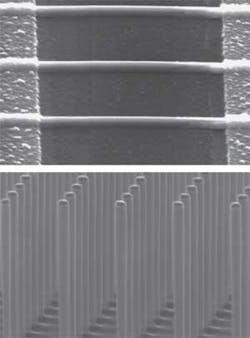Silicon (Si) nanowires are attractive as photodetectors for wavelengths ranging from ultraviolet (UV) to infrared because of their ability to trap carriers at the surface with high sensitivity. But precise nanowire positioning has limited their application as arrays, and measurement of phototransitive gain was not documented. Recently, researchers at the University of California—San Diego (La Jolla, CA) and Agiltron (Woburn, MA) fabricated planar and vertical Si nanowire photodetectors using an etching process, and reported the measurement of significant phototransitive gain for the first time.
Arthur Zhang and colleagues fabricated planar devices of multiple nanowires 250 nm in diameter and 8 µm in length, and vertical arrays of nanowires 200 nm in diameter and 2.7 µm in length. The group characterized the optical response of the devices using UV light at 390 nm. While both the planar and vertical nanowire devices demonstrated a reduced dark current because of a low physical fill factor, the vertical devices enabled strong waveguiding effects that increased the fill factor. The vertical array therefore produced a large gain of 35,000 at the lowest available light intensity, which may find use in optically integrated silicon electronics. Contact Arthur Zhang at [email protected].
